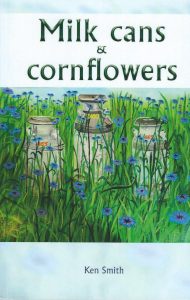 Reviewed by Ruth Latta
Reviewed by Ruth Latta
Milk cans & cornflowers
by Ken Smith
2023, ISBN 978-1-77216-258-5
When I used to teach creative writing courses, someone always asked me to define poetry, as if it were ineffable. Trying to use everyday terms, I’d say that a poem takes readers through an experience that expands their imaginations and stirs their emotions. Usually shorter than a story, a poem is elevated above ordinary prose through carefully chosen words, clever comparisons, and sometimes rhythm and rhyme.
The poems in Ken Smith’s collection, Milk cans & cornflowers, show a love of language that rises above workmanlike prose. The author lets readers experience walks along the St. Lawrence River; shares some of his past, points out striking objects or phenomena, and acknowledges the importance of family, including the “family” of great poets and writers of the past. Though his work is rooted in the St. Lawrence Seaway Valley of Eastern Ontario, Canada, his themes are too universal to be contained by any regional boundaries.
Ken’s interest in poetry was sparked in high school. An English Literature graduate from the University of Ottawa who subsequently studied Journalism, he has taught in Cornwall, Ontario schools and also in Korea (English as a Second Language). His life experience includes work as a farmhand, a truck driver for his family business, and a night watchman.
“I wish I could find two screwy words and put them together so that they fizz,” says one of the characters in a Diane Johnson novel. Ken’s word choice isn’t “screwy” so much as “vivid” and “clever”, with imaginative metaphors, brilliant word choices and startling end twists. His poem, “The Afternoon” is a good example of both a sustained metaphor and a progression of thought that surprises the reader.
“The Afternoon” starts with a teenager skipping school to buy a vinyl LP album because a classmate said it reminded her of him. (Who among us does not long to see ourselves as others see us?) The record becomes a metaphor, either for the ensuing relationship that goes bad, or, possibly for the personality traits in the young man that the girl saw in the music. The grooves became “ruts, now hard to get out of.” There is the “endless cycle of the turntable.” The LP becomes “dull and scratched.” Those who expected a gently nostalgic poem will find something deeper in “The Afternoon.”
“The Texaco Gas Pump” shows how a poet’s imagination works, and also pays homage to a literary luminary. A rusted gas pump in a field sets off an interesting train of thought captured in words. The gas pump once stood in front of a service station. Next, the poet notes that in the service station washroom there was likely a roll of paper towels “like [Jack] Kerouac might have fed/into his hungry typewriter/when he was ‘on the road’ [the title of Kerouac’s most famous book.]” The ending brings both poet and reader back to the present, to the poet’s brother’s back lot.
“The Odyssey” captures the atmosphere of a rainy night on the waterfront. The gateway to a floating dock is like passing through a “dream catcher’s net” beneath a “blood red moon”, with flashes of chain lightning in a “bruised, dark sky”, and the open river “ink blue.” The imagery makes readers feel that they were there.
“At Henderson’s Grocery” conveys the excitement of being “at the crossroads of a mighty river and Highway 401.” The sensory thrill of diesel engines and air brakes “makes you know that you are alive.” It reminded this reader of Walt Whitman’s “Crossing Brooklyn Ferry,” which also celebrates noise, movement and action.
At the very end of Milk Cans & cornflowers are three photos. One shows a page with the letterhead “Finch Cheese and Butter Factory”. In the second, a woman and two men pose for the camera, one man in the white attire of a food products worker. The third photograph shows a truck with “Smth Milk Transport, Cornwall, ON” painted on its door.
Ken devotes several poems to his youthful adventures working in the family business. In “A Gold Morning,” while collecting farmers’ cans of milk to take to the factory, he takes us through a musical list of towns: “Glen Becker, Bouck’s Hill, Williamsburg, to Kraft at Ingleside and back again.” The poem “At fourteen” shows a “green, carefree” lad driving a double-decker truckload of milk cans to his uncle’s cheese and butter factory, with the vehicle so heavily laden that the “front tires [are] barely touching blacktop.”
Another poem, “An old yellow lab” shows a teenager’s feelings when he accidentally “clipped” an ancient farm dog with the milk truck and killed it. “Vignette,” a prose poem gives us a glimpse at a bygone scene: a lonely old woman in a “faded brick house” surrounded by “tall, wet grass,” paying a boy in small change for a little brick of cheese.
One of my favourites shows us a black and white photo of three young children on tricycles in the back yard by the river. Seeing one sister on the “big trike”, the author wonders if it foreshadows her need of “serious transportation” for her future move to Calgary, Alberta as an adult. His other sister moved there too. The poem ends: “While I kind of bounced around writing it all down.”
Readers of Milk cans & cornflowers will be glad that Ken has been “writing it all down.”
About the reviewer: Ruth Latta’s latest Canadian historical novel, “A Striking Woman”, is about true love and union organizing.